Strategic Project of Shimane University International Exchanges
Shimane University set up the University Charter which mainly aims at developing human resources with rich humanity, expertise and activeness in learning, promoting research at global standard based on unique regional challenges, the enhancement of social action programs toward solving regional problems, and the reinforcement of international exchanges with in Asia and with other foreign countries.
For the purpose of implementing Shimane University’s Charter we made the Strategic Project of Shimane University International Exchanges, which is composed of three projects, namely (1) project for the development of human resources with expertise contributing to global society, (2) project for the development of a Regional Resource Cycle Society and (3) project for the development of Nanomaterials and Nanomedicine. The diagram below indicates the relationship of these projects.
The Strategic Project of Shimane University International Exchanges is expected to enhance internationalization at home institute and increase the number of students from foreign countries, expand the number of Shimane University students going abroad, increase the acquisition of outside funds, and result in increased transmission of the outcomes to the world.
In this section of this Prospectus, you can fi nd the general scheme and expected results of the three projects.
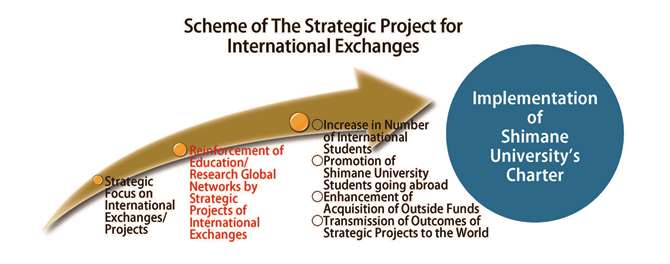
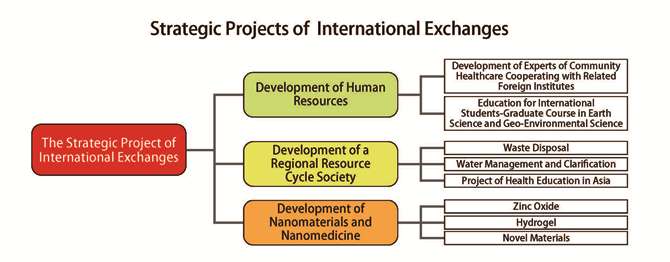
Development of Human Resources
(Cultivation of advanced experts capable of contributing to global society)
The progress of internationalization from pole to pole forges us to train our students to become the competent human resource and take part in global community.
In addition to a lot of oversea study training programs, namely English communication training programs and cross cultural experience programs, based on spirit of the Chapter of Shimane University, we have been implementing the Strategic International Project for the Development of Human Resources, which consists of two sub projects: (1) Development of Experts of Community Healthcare Cooperating with Related Foreign Institutes, and (2) Education for International Students-Graduate Course in Earth Science and Geo-Environmental Science.
1.Project for the Development of Experts of Community Healthcare Cooperating with Related Foreign Institutes
This project aims at (1) fostering the advancement of professionals of Community Healthcare, (2) transferring medical technologies and information to related foreign
institutes, (3) promoting international exchanges of researchers and students and (4) the promotion of medical English language ability by Shimane University students.
In 2013, 19 students of medical school visited to Waikato institute of technology in Hamilton, New Zealand for 2 weeks to learn English as well as to visit some New Zealand health facilities. In addition 9 students of medical school visited some medical school and hospitals in The United States, Thailand and Kazakhstan to learn community healthcare. One professor of University of Washington, Seattle was invited to have some sessions and lectures on community healthcare. To transfer medical technologies and information, 4 more exchange agreements with foreign institutes were signed.
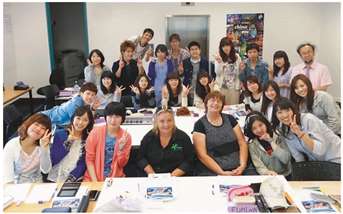 |
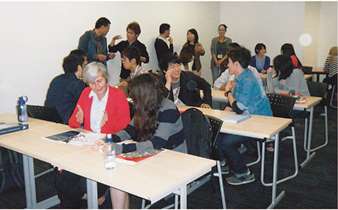 |
2.Project for Education for International Students-Graduates Course in Earth Science and Geoenvironmental Science
The graduate program accepts students of excellence mainly from Asia and the Pacific Rim regions. Research and education in the graduate program is based on geology and earth science, to solve worldwide problems
and to enhance sustainable development of the human world. Both the Master’s and doctoral programs are grouped into three courses, Advanced Earth Science, Earth Resource Science and Technology, and Geo-Environment and Natural Hazards. All courses are conducted in English.
The graduate program is aimed at producing international-level researchers and technical specialists in the earth sciences, geo-environmental sciences, and related fields.
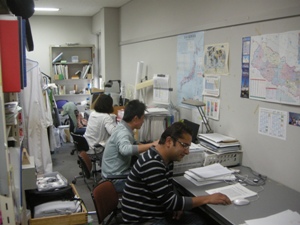 |
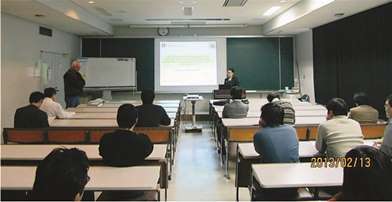 |
Development of a Regional Resource - Cycle Society (Toward a Sustainable and Active Region)
Forests, agricultural lands, rivers, lakes and the ocean are located close together in the landscape of Shimane Prefecture. These environmental features offer technological and industrial advantages for environmental restoration and the management of environmental resources. Shimane University, as a regional center of excellence, has been closely cooperating with regional entities such as Shimane prefecture and local cities to achieve these goals.
Our goal is to establish a Regional Resource-Cycle Society making contributions to the economic independence of our region, especially strategically collaborating with allied foreign universities.
This Regional Resource-Cycle Society will also deal with the regional decline brought on by an aging population in an area of intermediate and mountain terrains. Shimane University is also implementing the development of a health care system in Asia working together with universities overseas. This compromises an important part of the Regional Resource-Cycle Society mentioned above.
Greater prosperity can be achieved by developing food production, industrial production and advancement of health in harmony with environmental conservation and regional resource management.
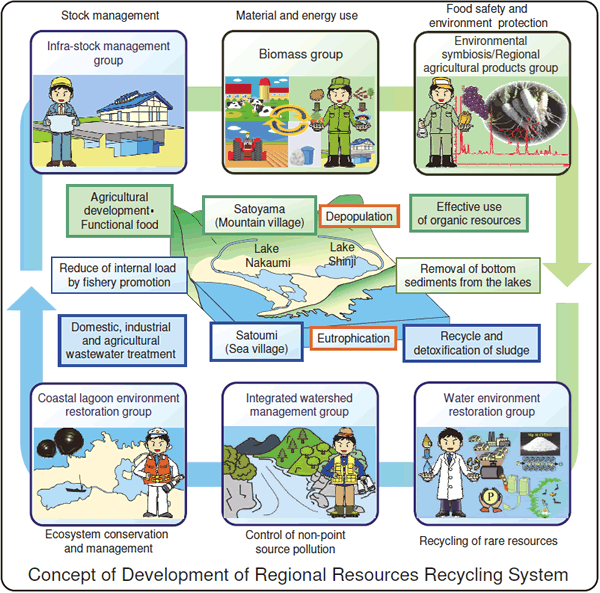
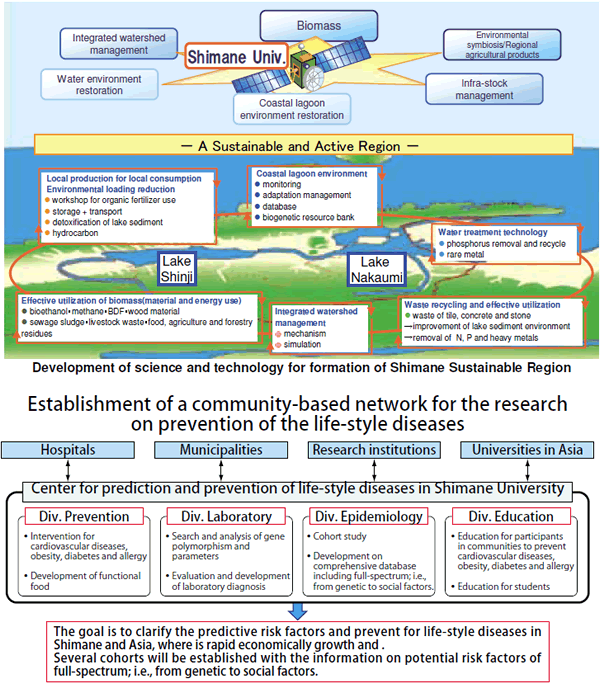
Development of Nanomaterials and Nanomedicine
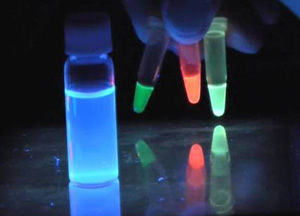 |
| Fluorescence of ZnO nanoparticles (left), GFP (Green Fluorescent Protein), CdSe quantum dots, and ZnO with functional groups (right). |
Nanotechnology opened a new scientific era by providing a totally new approach to materials science. It controls the structure of materials in nanometer(10 -9 m) scale, sometimes by sophisticated and expensive techniques. Shimane University has been a pioneer in nanotechnology that is simple, economical, and practical. Our technology makes it possible to accomplish material synthesis and its medical application in small factories. In this international project, we will develop new nanomaterials and nanomedicine based on the materials we have developed so far. Education is another important mission of this project. Students are provided an opportunity to join international research. Our collaborators include in the University of North Texas (USA), the University of Texas at Dallas (USA), Indiana University (USA), the National Cancer Institute (USA), Universität Bonn (Germany), and Buhan Institute of Technology (China), etc. The project consists of three sub-projects, i.e., Zinc Oxide, Hydrogel, and Novel Materials.
Zinc Oxide Project
| Student Exchange Workshop at University of North Texas. |
Zinc oxide (ZnO) is a material which has been studied at Shimane University with great success. We have developed ZnO nanoparticles which emit high quality blue or ultraviolet luminescence. In the present international project, nanophotonics of these ZnO particles and their application to medical technology are studied. Our goals are: 1) Elucidation of nanophotonic phenomena of ZnO. 2) Development of biomedical imaging technology for cells, tissues and organs. 3) Development of nanoscale photo-diagnostic and photo-therapeutic agents for cancer. We also study the safety, or toxicity, of nanomaterials on organisms.
Hydrogel Project
Hydrogel is a network of polymer chains that can contain over 99% water. In this international project, hydrogels are used to transport drugs to and make them active at target cancer cells. Our goal is the development of technology for molecular targeting therapy.
Novel Materials Project
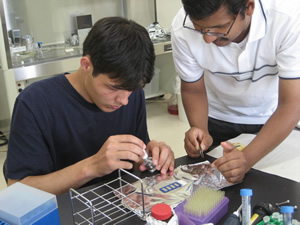 |
| Student from University of North Texas (left) working with a student from Shimane University. |
Shimane University has developed materials which are unique and useful. One example is a piezoelectric material, potassium-fluoride-doped barium titanate, which is now a candidate for lead-free material that replaces widelyused lead-containing piezoelectrics. In this international project, the mechanism of the piezoelectricity of this new material is studied. In addition other novel materials, such as piezoelectric, dielectric, or luminescent materials, are developed. Our goal is to supply new materials to the study of industrial and medical applications.
